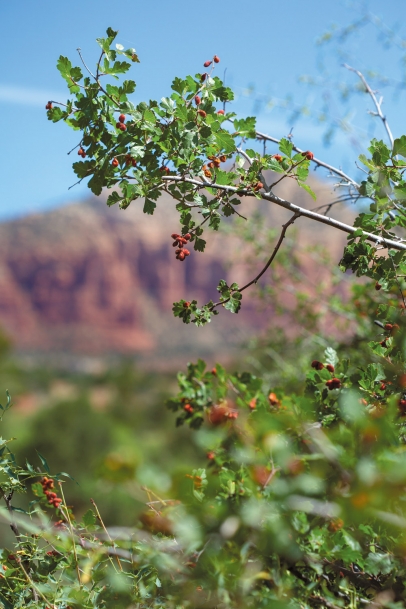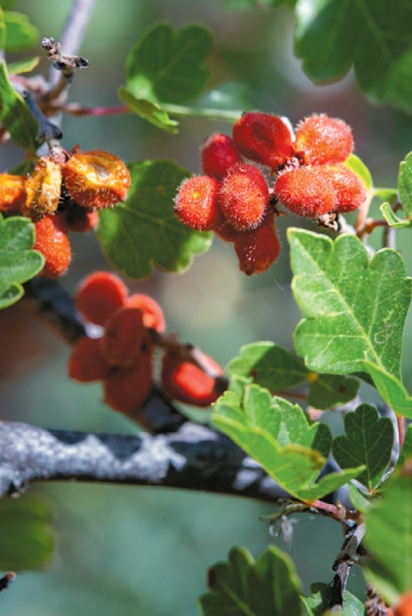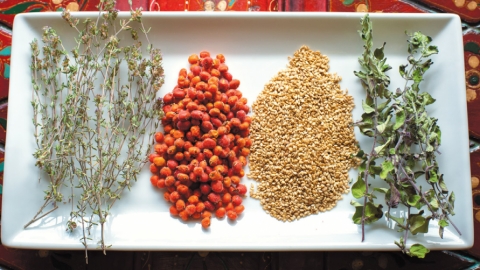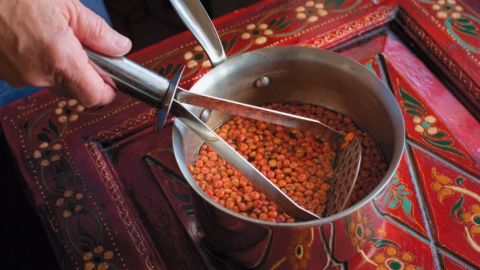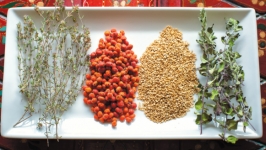Sumac Berries: Citrus in a Seed
Before the Spaniards brought lemons to the New World, there was sumac. From prehistoric times to the present, the bright red, slightly fuzzy berries have provided indigenous cooks a tart, zesty seasoning similar to lemons. For modern western cooks, it’s the best local spice we haven’t discovered.
Sumac grows all around the world and there are hundreds of species, some of them edible or useful in other ways. In the western United States Rhus trilobata, or three-leaf sumac, is the most widespread. Common English names include sourberry, squawbush, three-leaf sumac, lemonade berry, stinking sumac and skunk bush, due to the pungent odor in the leaves. In Navajo it is called chilchin.
You may have never noticed it, but you can probably find a bush growing in a natural setting somewhere nearby. Nine varieties of Rhus trilobata grow wild in arid regions west of the Mississippi from Saskatchewan to northern Mexico in diverse plant communities from low deserts up to mountain terrain at 7,000 feet, in grasslands and chaparral; in pine, juniper and fir forests; oak woodlands, rocky slopes, seasonal drainages, roadsides and wastelands. Sumac grows in sun or partial shade, over a wide variety of soils.
In the indigenous American diet, the berries have been used to make a refreshing beverage, sometimes referred to as the original pink lemonade. Ground up, the hulls are added for piquancy to meat stews, or used to enhance corn dishes.
Beyond culinary uses, the ubiquitous sumac bush has been deployed as a medicine. It is said to have antiseptic, antifungal and antioxidant properties and to be able to lower blood sugar levels in the treatment of diabetes (see ncbi.nlm.nih.gov/pmc/articles/PMC4232791/).
For Navajo weavers it is used as a dye, and as a mordant (color-fixing agent) for the dyeing process. The branches are used to make arrow shafts, loom rods, awls and other tools, and are stripped and split for basketry.
Harvesting Sumac
During the spring as the leaves unfurled, I identified several Rhus trilobata bushes in the piñon-juniper forest near my house.
I had to look carefully because the three-leaved sumac does not stand out. A rounded shrub of three to 15 feet in height, its grass-green, slightly shiny leaves have three lobes that faintly resemble oak leaves. The males do not bear fruit, but the female bushes blossom with tiny clusters of pale yellow flowers that turn into berries.
I mostly found the fruiting bushes crouched under a piñon pine or juniper tree, tangled in the company of prickly Emory oak or Fremont barberry bushes. These sumac plants probably sprang from seeds dropped by birds, but they can also propagate by shoots from rhizomes, creating thickets of clones sometimes seen on roadsides or hilly slopes.
In central Arizona, the berries ripen in June. At their peak, the clusters of eight to 12 sticky berries are easy to harvest. Over the course of a couple of weeks I leisurely gathered about two quarts of berries.
Processing the Sumac Berries
After picking, I cleaned out twigs, stems, leaves and other foreign debris, washed the fruits in a sieve and spread them out to dry on a tray.
Some I chose to dry completely and store in a jar for later use (see below). Some I used right away, infusing them in warm water to make an infusion of pink “lemonade,” which is easy to sweeten with prickly pear syrup, sugar, agave syrup or honey.
Like lemons, sumac berries provide an all-around seasoning. The infusion is a good substitute for vinegar or lemon juice. Sprinkle it on cooked greens or add a little to lentils or beans for a little tang.
Next I left the remaining berries to air dry on a plate for a few days until the skins became papery and flaked off the seeds when rubbed between my fingers.
Then I ground the seeds by hand with a mortar and pestle until the red hulls separated from the smooth, rock-hard seeds.
I then separated the hulls from the seeds by scooping and sliding them on a tilted plate—the seeds tend to roll away from the hulls, which I then scooped up with a little plastic cake scraper.
Alert: Thinking that a blender would work faster I tried putting the whole seeds in the jar and whirred them around until the red hulls separated from the seeds and became powder. However, I found that this method also chipped the seeds into the mix, creating an unpleasant stony grit.
Once the hulls were separated out from the seeds, I stored them in a glass jar, so they’d be ready to use as a seasoning and to make za’atar and chilchin.
Ground finely, sumac adds color and dimension to squash dishes, hummus, chicken, shrimp or fish. You may come to find it as useful as salt.
Note: In some areas of central Arizona another edible species, Rhus glabra, or smooth sumac, can be found in moist, well-drained soils and riparian areas. This variety has smooth bark, distinctive long pinate leaves and arching branches like staghorn sumac, and cone-shaped berry clusters, or bobs, which are easy to harvest and last through the winter.
Unlike poison sumac, which yields a white berry, all the edible varieties of sumac have bright red berries.
Sumac is in the Anacardiaceae family, as are cashews, mangoes and pistachios. If you are allergic to these foods, avoid sumac.
For more information: plants.usda.gov


